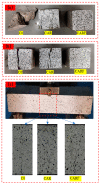The Mechanical Characteristics of High-Strength Self-Compacting Concrete with Toughening Materials Based on Digital Image Correlation Technology
- PMID: 36837324
- PMCID: PMC9967804
- DOI: 10.3390/ma16041695
The Mechanical Characteristics of High-Strength Self-Compacting Concrete with Toughening Materials Based on Digital Image Correlation Technology
Abstract
Brittle fracture is a typical mechanical characteristic of high-strength self-compacting concrete, and the research on its toughening modification remains the highlight in the engineering field. To understand the effect of toughening materials (including polymer latex powders, rubber particles, and polyethylene fibers) on the mechanical behavior of C80 high-strength self-compacting concrete under static loading, the failure mode, mechanical strength, strain field, and crack opening displacement (COD) of prepared high-strength self-compacting concrete under compressive, splitting, and flexural loads were studied based on digital image technology (DIC). The corresponding mechanism is also discussed. The results show that the hybrid of polymer latex powders, rubber particles, and polyethylene fibers can increase the crack path and inhibit the development of macrocracks in concrete, thus turning the fracture behavior of concrete from brittle to ductile. The addition of toughening materials reduced the compressive and flexural strengths of high-strength self-compacting concrete, but it increased the splitting strength. DIC showed that the incorporation of toughening materials promoted the redistribution of strain and reduced the degree of strain concentration in high-strength self-compacting concrete. The evolution of COD in high-strength self-compacting concrete can be divided into two stages, including the linear growth stage and the plastic yield stage. The linear growth stage can be extended by incorporating toughening materials. The COD and energy absorption capacity of concrete were enhanced with the addition of toughening materials, and the best enhancement was observed with the hybrid of polymer latex powders, rubber particles, and polyethylene fibers. Overall, this research provides a reference for exploring effective technical measures to improve the toughness of high-strength self-compacting concrete.
Keywords: crack; digital image correlation (DIC); high-strength self-compacting concrete; strength; toughening materials.
Conflict of interest statement
The authors declare no conflict of interest.
Figures












Similar articles
-
Research on the mechanical properties of hybrid Steel Fiber-Reinforced Self-Compacting Concrete based on the DIC method.PLoS One. 2025 May 15;20(5):e0322450. doi: 10.1371/journal.pone.0322450. eCollection 2025. PLoS One. 2025. PMID: 40373094 Free PMC article.
-
Mechanical Properties and Crack Resistance of Basalt Fiber Self-Compacting High Strength Concrete: An Experimental Study.Materials (Basel). 2023 Jun 14;16(12):4374. doi: 10.3390/ma16124374. Materials (Basel). 2023. PMID: 37374559 Free PMC article.
-
Fracture Behavior of Steel-Fiber-Reinforced High-Strength Self-Compacting Concrete: A Digital Image Correlation Analysis.Materials (Basel). 2025 Aug 1;18(15):3631. doi: 10.3390/ma18153631. Materials (Basel). 2025. PMID: 40805509 Free PMC article.
-
A Review on Multi-Scale Toughening and Regulating Methods for Modern Concrete: From Toughening Theory to Practical Engineering Application.Research (Wash D C). 2024 Dec 26;7:0518. doi: 10.34133/research.0518. eCollection 2024. Research (Wash D C). 2024. PMID: 39726918 Free PMC article. Review.
-
The Influence of Fiber on the Mechanical Properties of Geopolymer Concrete: A Review.Polymers (Basel). 2023 Feb 7;15(4):827. doi: 10.3390/polym15040827. Polymers (Basel). 2023. PMID: 36850111 Free PMC article. Review.
Cited by
-
Investigation into the Time-Dependent Crack Propagation Rate of Concrete.Materials (Basel). 2023 Mar 14;16(6):2337. doi: 10.3390/ma16062337. Materials (Basel). 2023. PMID: 36984215 Free PMC article.
References
-
- Mardani-Aghabaglou A., Karakuzu K., Kobya V., Hatungimana D. Durability performance and dimensional stability of road concrete containing dry-shake surface hardener admixture. Constr. Build. Mater. 2021;274:121789. doi: 10.1016/j.conbuildmat.2020.121789. - DOI
-
- Ahmad J., Zhou Z.G., Martínez-García R. A study on the microstructure and durability performance of rubberized concrete with waste glass as binding material. J. Build. Eng. 2022;49:104054. doi: 10.1016/j.jobe.2022.104054. - DOI
-
- Li N., Long G.C., Ma C., Fu Q., Zeng X.H., Ma K.L., Xie Y.J., Luo B.T. Properties of self-compacting concrete (SCC) with recycled tire rubber aggregate: A comprehensive study. J. Clean. Prod. 2019;236:117707. doi: 10.1016/j.jclepro.2019.117707. - DOI
-
- Qian C.X., Steroeven P. Development of hybrid polypropylene-steel fibre-reinforced concrete. Cem. Concr. Res. 2000;30:63–69. doi: 10.1016/S0008-8846(99)00202-1. - DOI
-
- Nataraja M.C., Dhang N., Gupta A.P. Toughness characterization of steel fiber-reinforced concrete by JSCE approach. Cem. Concr. Res. 2000;30:593–597. doi: 10.1016/S0008-8846(00)00212-X. - DOI
Grants and funding
- Grant No.202004AR040022/Yunnan Provincial Science and Technology Project
- Grant No.2021JJ40165/Hunan Provincial Natural and Science Foundation
- Grant No.20B161/Scientific research project of Hunan Provincial Department of Education
- 202111528004/National College Students` Innovation and Entrepreneurship Training Program
LinkOut - more resources
Full Text Sources

